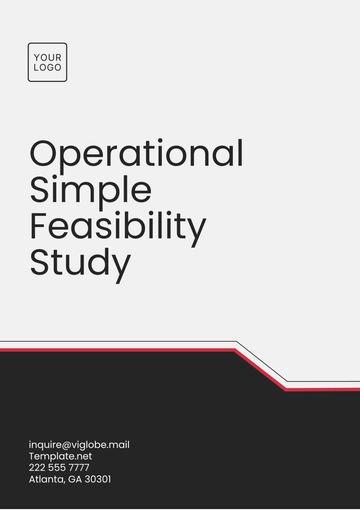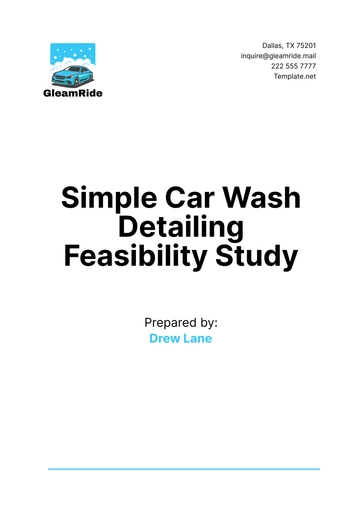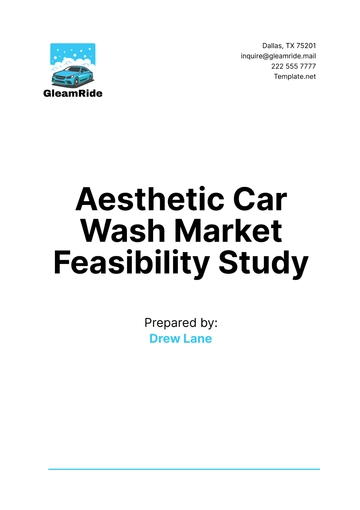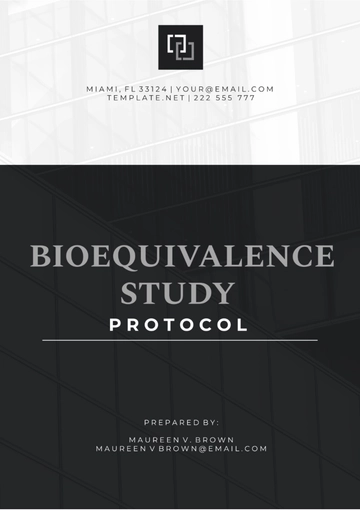Free Aesthetic Car Wash Market Feasibility Study
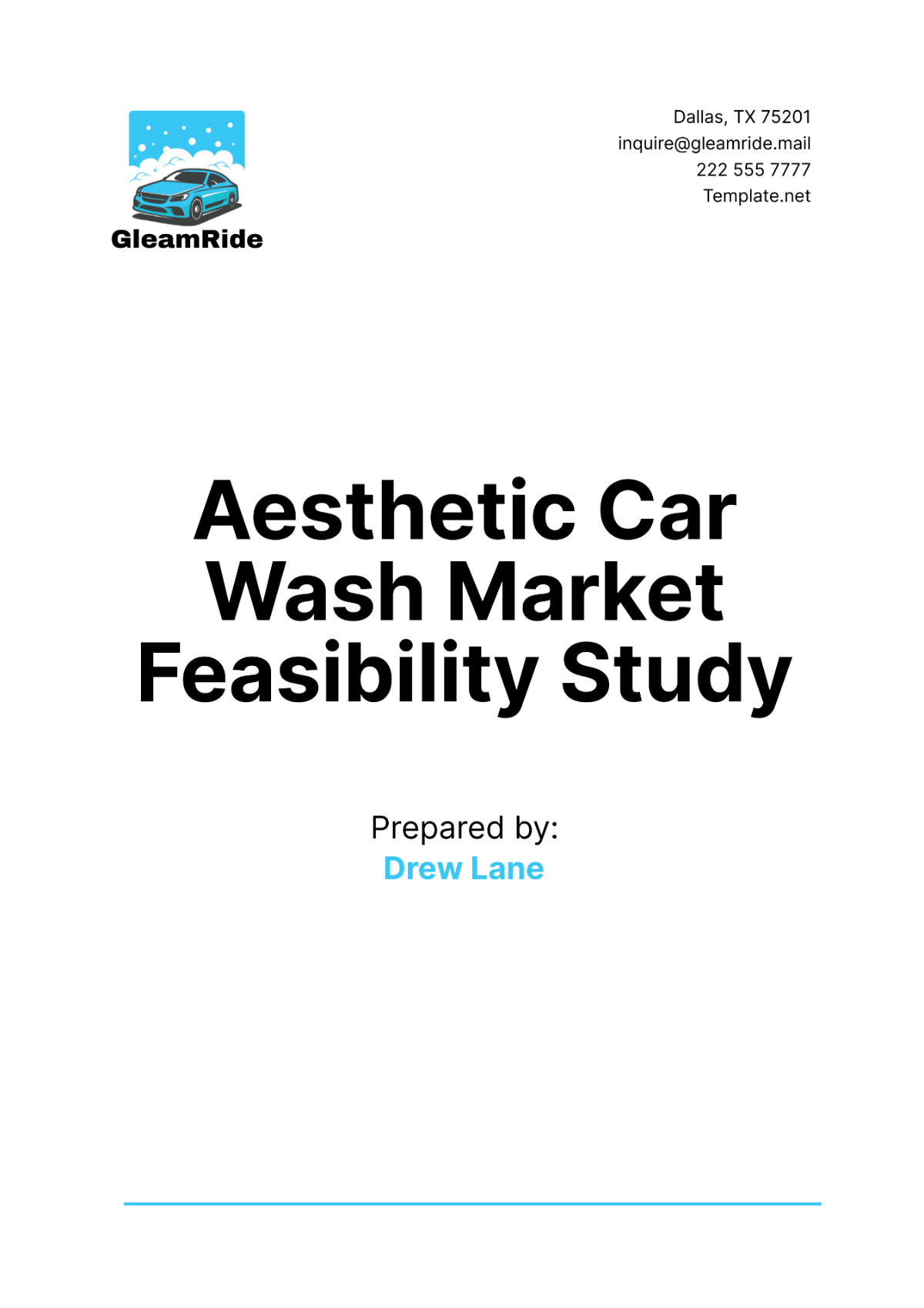
I. Introduction
A. Purpose
The purpose of this Aesthetic Car Wash Market Feasibility Study is to evaluate the potential success of establishing an aesthetic car wash business under the name of [Your Company Name]. This study will analyze various factors that influence the feasibility of the business, including market analysis, competition, financial projections, and operational considerations.
B. Objectives
Determine Market Demand: To assess the demand for aesthetic car wash services in the target market. Understanding market demand helps in estimating the potential customer base and revenue.
Analyze Competitors: To evaluate the competitive landscape and identify key competitors. Analyzing competitors provides insights into market positioning and differentiation strategies.
Financial Projections: To project the financial performance of the business, including revenue, costs, and profitability. Financial projections help in determining the viability of the business.
Operational Considerations: To identify operational requirements and challenges for running the car wash business. Operational considerations ensure smooth and efficient business operations.
Strategic Recommendations: To provide strategic recommendations based on the findings of the study. Recommendations guide decision-making and planning for business success.
II. Market Analysis
Understanding the market is crucial for assessing the feasibility of the aesthetic car wash business. The following table presents key market data and insights:
No. | Market Segment | Description |
|---|---|---|
1 | Target Demographics | Young professionals and car enthusiasts |
2 | Market Size | Estimated at $2,000,000 annually |
3 | Growth Rate | Projected annual growth rate of 5% |
4 | Customer Preferences | High-quality service and eco-friendly products |
A. Target Demographics
Young Professionals: The primary target demographic includes young professionals who own mid to high-end vehicles. They prioritize convenience and quality service, making them ideal customers for premium car wash services.
Car Enthusiasts: Another significant segment includes car enthusiasts who are particular about the appearance and maintenance of their vehicles. They seek specialized services and are willing to pay a premium for superior results.
B. Market Size
Current Market Size: The market for car wash services in the target area is estimated at $2,000,000 annually. This substantial market size indicates a strong demand for car wash services.
Potential for Growth: Given the increasing number of vehicle owners and the rising awareness of vehicle aesthetics, the market size is expected to grow further. This growth potential presents an attractive opportunity for entering the market.
C. Growth Rate
Annual Growth: The car wash market is projected to grow at an annual rate of 5%. This steady growth rate suggests a healthy and expanding market, making it feasible to launch a new business.
Factors Influencing Growth: Factors such as urbanization, increasing disposable income, and a growing emphasis on vehicle maintenance contribute to the market’s growth. These factors support the long-term sustainability of the business.
D. Customer Preferences
High-Quality Service: Customers prefer car wash services that offer high-quality cleaning and detailing. Ensuring high standards of service will attract and retain customers.
Eco-Friendly Products: There is a growing trend towards eco-friendly car wash products and practices. Adopting environmentally sustainable methods will appeal to environmentally conscious customers.
The insights from the market analysis indicate a robust demand for aesthetic car wash services, a substantial market size with growth potential, and customer preferences that align with premium and eco-friendly services.
III. Competitive Analysis
A thorough analysis of competitors is essential to understand the competitive landscape and identify opportunities for differentiation. The following table summarizes key competitors in the target market:
No. | Competitor Name | Strengths | Weaknesses |
|---|---|---|---|
1 | Sparkle Auto | Established brand, multiple locations | Higher prices, limited service diversity |
2 | Eco Wash | Eco-friendly products, loyal customer base | Smaller operational scale, fewer locations |
3 | Shine Drive | High-quality service, strong online presence | Limited operating hours, high staff turnover |
4 | Speedy Wash | Competitive pricing, fast service | Inconsistent service quality, basic facilities |
A. Sparkle Auto
Strengths: Sparkle Auto is an established brand with multiple locations, offering convenience and brand recognition. Their widespread presence provides a competitive edge in terms of accessibility.
Weaknesses: Their higher prices may deter price-sensitive customers, and their limited service diversity might not cater to all customer preferences. These weaknesses provide opportunities for [Your Company Name] to offer competitive pricing and diverse services.
B. Eco Wash
Strengths: Eco Wash specializes in eco-friendly products and has a loyal customer base. Their commitment to sustainability appeals to environmentally conscious customers.
Weaknesses: Their smaller operational scale and fewer locations limit their market reach. [Your Company Name] can capitalize on this by expanding locations and offering similar eco-friendly services at a larger scale.
C. Shine Drive
Strengths: Shine Drive is known for high-quality service and a strong online presence, which helps in attracting and retaining customers. Their online presence also facilitates customer engagement and marketing.
Weaknesses: Limited operating hours and high staff turnover can affect service availability and consistency. Addressing these issues can help [Your Company Name] offer more reliable and accessible services.
D. Speedy Wash
Strengths: Speedy Wash offers competitive pricing and fast service, attracting customers looking for quick and affordable options. Their pricing strategy makes them a popular choice among budget-conscious customers.
Weaknesses: Inconsistent service quality and basic facilities can deter customers seeking a premium experience. [Your Company Name] can differentiate by ensuring consistent, high-quality service and superior facilities.
The competitive analysis reveals that there are opportunities for [Your Company Name] to differentiate itself through competitive pricing, diverse and eco-friendly services, reliable operations, and superior facilities.
IV. Financial Analysis
Financial analysis is crucial for determining the viability of the aesthetic car wash business. The following chart and table present the projected financial performance for the first year of operation:
No. | Financial Metric | Amount |
|---|---|---|
1 | Initial Investment | $150,000 |
2 | Monthly Revenue | $25,000 |
3 | Monthly Expenses | $15,000 |
4 | Monthly Profit | $10,000 |
5 | Annual Revenue | $300,000 |
6 | Annual Expenses | $180,000 |
7 | Annual Profit | $120,000 |
A. Initial Investment
Startup Costs: The initial investment of $150,000 covers startup costs such as equipment, facilities, and initial marketing efforts. This investment is necessary to establish a fully operational car wash business.
Funding Sources: Potential funding sources include personal savings, loans, or investors. Securing adequate funding ensures the business can cover initial expenses and start operations smoothly.
B. Monthly Revenue
Revenue Streams: The projected monthly revenue of $25,000 is based on the estimated number of customers and pricing strategy. Revenue streams include standard car wash services, detailing, and premium packages.
Revenue Growth: Revenue is expected to grow as the business gains traction and builds a customer base. Effective marketing and high service quality will drive revenue growth over time.
C. Monthly Expenses
Operational Costs: Monthly expenses of $15,000 include salaries, utilities, supplies, and maintenance. These costs are essential for maintaining daily operations and service quality.
Expense Management: Effective expense management can help in optimizing costs and improving profitability. Regular monitoring and cost control measures are necessary for financial stability.
D. Monthly Profit
Profitability: The projected monthly profit of $10,000 indicates a healthy profit margin. Profitability ensures the business can sustain operations and invest in growth opportunities.
Reinvestment: Profits can be reinvested into the business for expansion, marketing, and enhancing service quality. Reinvestment supports long-term growth and competitiveness.
E. Annual Revenue
Total Revenue: The annual revenue of $300,000 reflects the cumulative earnings from monthly operations. Consistent revenue generation is key to the financial success of the business.
Revenue Projections: Accurate revenue projections help in setting realistic financial goals and planning for future growth. Regular review and adjustment of projections are necessary to reflect market conditions.
F. Annual Expenses
Total Expenses: Annual expenses of $180,000 cover all operational costs incurred throughout the year. Managing these expenses is crucial for maintaining profitability.
Cost Efficiency: Implementing cost-efficient practices can reduce expenses without compromising service quality. Cost efficiency enhances overall financial performance.
G. Annual Profit
Net Profit: The annual profit of $120,000 demonstrates the business's potential for financial success. Achieving this profit level requires effective management and operational efficiency.
Financial Health: Positive annual profit indicates good financial health and the ability to sustain and grow the business. Maintaining financial health ensures long-term viability and success.
The financial analysis indicates that [Your Company Name] has the potential to achieve significant profitability with careful management of revenue and expenses. Ensuring cost efficiency and effective reinvestment of profits will support sustainable growth and financial stability.
V. Operational Plan
An effective operational plan is essential for the smooth functioning of the car wash business. The following table outlines the key operational requirements:
No. | Aspect | Description |
|---|---|---|
1 | Staffing | Hiring and training of staff |
2 | Equipment | Acquisition and maintenance of car wash equipment |
3 | Facility Management | Management of the car wash facility |
4 | Service Procedures | Standard operating procedures for car wash services |
A. Staffing
Hiring Process: Implement a thorough hiring process to recruit qualified and experienced staff. Hiring skilled employees ensures high service quality and operational efficiency.
Training Programs: Develop comprehensive training programs to equip staff with the necessary skills and knowledge. Continuous training enhances staff competency and service standards.
Employee Retention: Focus on employee retention strategies to maintain a stable and motivated workforce. Retaining skilled staff reduces turnover costs and ensures consistency in service delivery.
Role Allocation: Clearly define roles and responsibilities to ensure efficient workflow and accountability. Proper role allocation helps in achieving operational efficiency and service excellence.
Performance Monitoring: Regularly monitor and evaluate staff performance to identify areas for improvement. Performance monitoring supports continuous improvement and high service standards.
B. Equipment
Acquisition: Acquire high-quality car wash equipment to ensure efficient and effective service delivery. Investing in reliable equipment minimizes downtime and maintenance costs.
Maintenance: Implement a regular maintenance schedule to keep equipment in optimal working condition. Regular maintenance extends the lifespan of equipment and prevents breakdowns.
Upgrades: Periodically upgrade equipment to incorporate the latest technology and improve service quality. Upgrading equipment enhances operational efficiency and customer satisfaction.
Inventory Management: Maintain an adequate inventory of supplies and spare parts to support uninterrupted operations. Effective inventory management ensures readiness for any operational contingencies.
C. Facility Management
Facility Layout: Design an efficient facility layout to optimize workflow and customer experience. An effective layout enhances operational efficiency and customer satisfaction.
Cleanliness and Safety: Ensure the facility is clean, safe, and well-maintained at all times. Maintaining a clean and safe environment is crucial for customer satisfaction and compliance with health regulations.
Utility Management: Manage utility usage to ensure cost efficiency and environmental sustainability. Efficient utility management reduces operational costs and supports eco-friendly practices.
Facility Upgrades: Periodically upgrade the facility to maintain a modern and appealing environment. Facility upgrades enhance the overall customer experience and competitiveness.
Security Measures: Implement security measures to protect the facility, equipment, and customers. Ensuring security is essential for building trust and maintaining a safe environment.
D. Service Procedures
Standard Operating Procedures: Develop and implement standard operating procedures for all car wash services. Standard procedures ensure consistency and high quality in service delivery.
Service Customization: Offer customized service options to cater to diverse customer preferences. Customizing services enhances customer satisfaction and loyalty.
Quality Control: Implement quality control measures to ensure all services meet high standards. Quality control supports continuous improvement and customer satisfaction.
Time Management: Optimize service time to ensure efficiency and minimize customer wait times. Effective time management improves customer experience and operational productivity.
Feedback Mechanisms: Establish feedback mechanisms to gather customer insights and improve services. Customer feedback helps in identifying areas for improvement and enhancing service quality.
Sustainability Practices: Incorporate eco-friendly practices in service procedures to promote environmental sustainability. Adopting sustainable practices appeals to environmentally conscious customers.
The operational plan outlines the key aspects of running a successful car wash business, emphasizing the importance of staffing, equipment, facility management, and service procedures.
VI. Risk Assessment
Identifying and mitigating risks is crucial for the successful operation of the aesthetic car wash business. The following table summarizes potential risks and mitigation strategies:
No. | Risk | Mitigation Strategy |
|---|---|---|
1 | Market Competition | Differentiation and superior service quality |
2 | Economic Downturn | Diversified revenue streams and cost control |
3 | Operational Disruptions | Regular maintenance and contingency planning |
4 | Regulatory Compliance | Adherence to regulations and regular audits |
5 | Customer Dissatisfaction | Continuous improvement and feedback mechanisms |
A. Market Competition
Differentiation: Differentiate the business through unique service offerings and superior quality. Differentiation helps in standing out in a competitive market.
Customer Loyalty: Build strong customer relationships and loyalty programs to retain customers. Customer loyalty ensures a stable revenue stream even in a competitive environment.
B. Economic Downturn
Revenue Diversification: Diversify revenue streams by offering additional services or products. Revenue diversification reduces reliance on a single income source and enhances financial stability.
Cost Management: Implement cost control measures to manage expenses effectively. Cost management helps in maintaining profitability during economic downturns.
C. Operational Disruptions
Maintenance Schedule: Follow a regular maintenance schedule to prevent equipment breakdowns. Regular maintenance ensures uninterrupted operations and service delivery.
Contingency Planning: Develop contingency plans for potential operational disruptions. Contingency planning prepares the business for unexpected challenges and ensures quick recovery.
D. Regulatory Compliance
Regulatory Adherence: Ensure compliance with all relevant regulations and standards. Regulatory adherence prevents legal issues and fines, ensuring smooth operations.
Regular Audits: Conduct regular audits to ensure ongoing compliance and identify areas for improvement. Regular audits help in maintaining high standards and avoiding regulatory violations.
E. Customer Dissatisfaction
Continuous Improvement: Implement continuous improvement practices to enhance service quality. Continuous improvement addresses customer concerns and enhances satisfaction.
Feedback Mechanisms: Establish robust feedback mechanisms to gather and act on customer feedback. Feedback mechanisms help in identifying and addressing issues promptly.
Identifying potential risks and implementing effective mitigation strategies ensures the long-term success and stability of the aesthetic car wash business.
VII. Marketing Strategy
A comprehensive marketing strategy is essential for attracting and retaining customers. The following table outlines key marketing initiatives.
No. | Marketing Initiative | Description |
|---|---|---|
1 | Digital Marketing | Online advertising, social media, and SEO |
2 | Loyalty Programs | Reward programs for repeat customers |
3 | Partnerships | Collaborations with local businesses |
4 | Promotional Events | Special events and discounts to attract customers |
A. Digital Marketing
Online Advertising: Invest in online advertising to reach a broad audience. Online advertising includes pay-per-click ads, social media ads, and display ads, driving traffic to the business.
Social Media Engagement: Utilize social media platforms to engage with customers and promote services. Regular posts, stories, and customer interactions build a strong online presence and community.
SEO Optimization: Optimize the business website for search engines to increase visibility. Effective SEO strategies improve search rankings and attract organic traffic.
Content Marketing: Create valuable content such as blogs, videos, and infographics related to car care. Content marketing educates customers and positions the business as an industry authority.
Email Campaigns: Implement email marketing campaigns to keep customers informed about promotions and updates. Personalized emails enhance customer relationships and drive repeat business.
B. Loyalty Programs
Reward Points: Implement a reward points system for frequent customers. Customers earn points for each visit, which can be redeemed for discounts or free services.
Membership Plans: Offer membership plans with exclusive benefits such as discounted rates and priority service. Membership plans encourage repeat business and customer loyalty.
Referral Incentives: Provide incentives for customers who refer new clients. Referral programs expand the customer base and reward loyal customers.
Special Offers: Regularly offer special deals and discounts to loyal customers. Special offers keep customers engaged and encourage repeat visits.
C. Partnerships
Local Businesses: Partner with local businesses to cross-promote services. Collaborations with automotive shops, dealerships, and other local businesses expand reach and attract new customers.
Community Events: Participate in community events and sponsorships to increase visibility. Community involvement builds brand awareness and strengthens community relationships.
Corporate Deals: Offer corporate deals for businesses with vehicle fleets. Corporate partnerships provide a steady stream of business and enhance brand credibility.
Charity Collaborations: Collaborate with charities for fundraising events and promotions. Charity partnerships enhance the brand’s image and attract socially conscious customers.
D. Promotional Events
Grand Opening: Host a grand opening event with special offers and activities to attract initial customers. A successful grand opening creates buzz and sets the stage for future success.
Seasonal Discounts: Offer discounts and promotions during peak seasons to boost sales. Seasonal promotions attract customers during high-demand periods.
Customer Appreciation Day: Organize customer appreciation events to thank loyal customers. Appreciation events build stronger relationships and encourage repeat business.
Service Demonstrations: Conduct service demonstrations and workshops to showcase expertise. Demonstrations educate customers about services and build trust.
Holiday Specials: Provide special deals and packages during holidays to attract customers. Holiday promotions capitalize on increased consumer spending.
Feedback Events: Host events where customers can provide feedback and suggestions. Feedback events show customers that their opinions are valued and help improve services.
A well-rounded marketing strategy that combines digital marketing, loyalty programs, partnerships, and promotional events will attract and retain customers, driving the success of [Your Company Name].
VIII. Recommendations
Based on the feasibility study, the following recommendations are proposed to ensure the success of [Your Company Name].
A. Service Expansion
Add-On Services: Introduce add-on services such as detailing, waxing, and interior cleaning. Offering a variety of services caters to diverse customer needs and increases revenue.
Mobile Services: Consider offering mobile car wash services for customer convenience. Mobile services expand the customer base and provide a competitive edge.
Eco-Friendly Options: Incorporate eco-friendly cleaning products and practices to attract environmentally conscious customers. Eco-friendly services differentiate the business and promote sustainability.
B. Customer Engagement
Loyalty Programs: Implement robust loyalty programs to reward repeat customers. Loyalty programs enhance customer retention and encourage repeat business.
Feedback Systems: Establish feedback systems to gather customer insights and improve services. Customer feedback is crucial for continuous improvement and satisfaction.
Community Involvement: Engage with the local community through events and sponsorships. Community involvement builds brand awareness and fosters positive relationships.
C. Financial Management
Cost Control: Implement cost control measures to manage expenses effectively. Cost control enhances profitability and financial stability.
Revenue Diversification: Diversify revenue streams by offering additional services and products. Revenue diversification reduces financial risk and increases profitability.
Investment in Technology: Invest in advanced technology to improve service efficiency and quality. Technological advancements enhance operational efficiency and customer satisfaction.
Implementing these recommendations will support the growth and success of [Your Company Name] in the competitive car wash market.
IX. Conclusion
This Aesthetic Car Wash Market Feasibility Study of [Your Company Name] indicates a strong potential for success. The study highlights the demand for high-quality car wash services, supported by a comprehensive market analysis, financial projections, and operational plan. Key recommendations, including service expansion, customer engagement, and financial management, are essential for long-term success.
By implementing tailored strategies, [Your Company Name] can establish itself as a leading provider of aesthetic car wash services, ensuring sustainable growth and profitability in the competitive market. This feasibility study provides a solid foundation for the strategic planning and execution of the car wash business, ensuring a prosperous future.
- 100% Customizable, free editor
- Access 1 Million+ Templates, photo’s & graphics
- Download or share as a template
- Click and replace photos, graphics, text, backgrounds
- Resize, crop, AI write & more
- Access advanced editor
Evaluate market feasibility with ease with the Aesthetic Car Wash Market Feasibility Study Template available on Template.net! This customizable and user-friendly template provides an organized format for market analysis. The editable sections allow for detailed insights. Enhance your feasibility study using the AI Editor Tool! Get access to get started!





